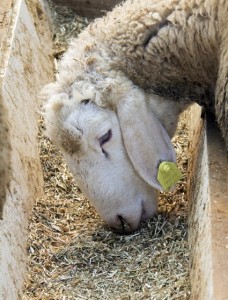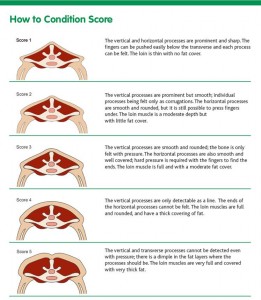 Our sustainable livestock principles include the requirement for forages and grazing to be the main source of nutrients for ruminants and in most sheep systems that is the case. However, in most systems there will also be periods when additional supplementation may be needed, either when there is little grazing available or because of increased nutritional demands during key periods of the reproductive cycle. It is normal to supplement during late pregnancy, early lactation or during periods when animals are growing rapidly and the nutritional requirements are high. It is also normal practice to supplement when there are known mineral deficiencies. Nutrition can influence health and welfare in so many ways, and there is growing evidence that the composition of feeds can influence, for example, gastro-intestinal parasites
Our sustainable livestock principles include the requirement for forages and grazing to be the main source of nutrients for ruminants and in most sheep systems that is the case. However, in most systems there will also be periods when additional supplementation may be needed, either when there is little grazing available or because of increased nutritional demands during key periods of the reproductive cycle. It is normal to supplement during late pregnancy, early lactation or during periods when animals are growing rapidly and the nutritional requirements are high. It is also normal practice to supplement when there are known mineral deficiencies. Nutrition can influence health and welfare in so many ways, and there is growing evidence that the composition of feeds can influence, for example, gastro-intestinal parasites
Minerals and Trace Elements
Nutrition and Internal Parasites
What are Tannins?
Sustainable Feeds
Energy and Body Condition
Energy is normally the most limiting nutrient in sheep diets and energy deficiency is the most common nutritional deficiency, particularly at key stages of reproduction, resulting in poor conception, fewer lambs born and ewes having insufficient milk to rear lambs. Energy deficiency can also increase susceptibility to diseases, particularly gastro-intestinal worms. Conversely, excess energy results in excessive fat deposition, which can cause reproductive problems, including pregnancy toxaemia or ketosis.
What is body condition scoring?
Throughout the production cycle, farmers must know whether or not their sheep are in condition (too thin, too fat, or just right) for the stage of production: breeding, late pregnancy, lactation. A body condition score estimates condition of muscling and fat development. Scoring is based on feeling the level of muscling and fat deposition over and around the vertebrae in the loin region.
Body condition scores can provide more superior estimates of the proportion of fat and hence energy reserves in the live animal than live weight measures (Russel et al., 1969).Ewes deal successfully with extreme nutritional conditions although a BCS of 3 appears to be ideal to assure nutritional and metabolic welfare and with a BCS below 2 or above 3 ewes seem more susceptible to metabolic imbalances (Caldeira et al., 2007).
This Sheep Condition Scoring video demonstrates how to conduct body condition scoring and what to do with the results.
.
Minerals and Trace Elements

Concentrate feeds are frequently fortified with minerals, which can prevent deficiencies, but excessive use can also result in environmental pollution
What for?
Minerals and trace elements also play a key role in a wide range of bodily functions, including structural and biochemical functions. Trace minerals must be provided to livestock in optimal concentrations and according to requirements that change during the rapid growth and development of the animal and the production cycle. Optimal nutrition, with adequate trace mineral levels, guarantees proper structural, physiological, catalytic, and regulatory functions of animals. Estimates of the requirements are often based on the minimum level required to overcome a deficiency rather than to maximise the benefits. There are issues with the diagnosis and anticipation of trace element deficiencies in grazing livestock and Suttle (1986) recommended preventive measures that are prompted by biochemical evidence of marginal deficiencies in animals rather than in soils or pastures. The relationships between soil mineral levels and those in animals is in general, quite complex and affected by geology and soil chemistry, climate, intensity of the agricultural systems, nature of the vegetative cover and characteristics and livestock management (Reid and Horvarth, 1980).
How much?
Estimates of requirements also need to take account of the potentially negative, or antagonistic, effects of deficiencies and excesses of other nutrients. It is also important to consider the form of the natural ingredient that contains the mineral e.g. what are the effects of processing (López-Alonso, 2012). A significant proportion of minerals that are given to livestock are excreted in urine and faeces, particularly in intensive systems where many concentrated feeds are fortified with minerals. This increases the margin of mineral supply over mineral requirement (Suttle, 2010), and increases the risk of environmental pollution of minerals excreted from farm animals.
Calcium
is used in the mineralisation of bones and teeth, nerve conduction, muscle contraction, blood clotting, hormone secretion and message transmission. Whilst marginal deficiency can result in reduced growth and milk production, severe deficiency can lead to enlarged painful joints and lameness and malformed teeth and jaws. It can also result in milk fever, including muscle tremors as well as general inertia and inappetance and ultimately in death.
Calcium deficiency is most commonly seen during lactation when there is an increased demand for calcium, and especially during drought periods and when animals are fed a high grain diet or when animals are deficient in vitamin D. It is a particular issue in low calcium soils found in some tropical areas.
Phosphorus deficiency
occurs in phosphorus deficient soils, and particularly in areas prone to long dry seasons. It is involved in bone formation and energy metabolism as well as being a component part of the structural framework of the nucleic acids, DNA and RNA. DNA and RNA, along with proteins and carbohydrates, are essential macromolecules found in all life forms. Marginal deficiency can result in reduced growth and reproduction. Severe deficiency can result in softening of bones, lameness and depressed appetite. There is also a link to botulism, particularly in phosphorus deficient pastures when in extreme cases animals may look to supplement their diet by consuming bones, which in some situations may presents a botulism risk (Meyer, 1956; Döbereiner et al., 1992). Phosphorus is also involved in maintaining the body’s acid-base balance or pH.
Sodium
As with phosphorus, sodium is also involved in maintaining acid-base balance, as well as being an essential nutrient that regulates blood volume, blood pressure and osmotic equilibrium. It is also necessary for growth of the predominant species of bacteria in the rumen (Caldwell and Hudson, 1974). Sodium deficiency can result in abnormal appetite for substances that are largely non-nutritive (pica), especially licking of soil, reduced growth and possibly loss of weight and decreased milk production. Deficiency are most likely in rapidly growing or lactating sheep, and particularly so in tropical or dry arid climates, and also in animals fed a high grain diet.
Suphur Deficiency
Some soils are low in sulphur, which can result in sheep suffering from sulphur deficiency. It is an essential component in all living cells, being an important component in the amino acids methionine and cysteine and in the vitamins biotin and thiamine. It is also involved in cartilage and joint lubrication and the removal and storage of toxic elements and compounds. A relatively small increase in the intake of sulphur (0·36 g/day) can markedly improve the nutritive value to sheep of a sulphur-deficient, low protein roughage (Bird, 1972).
Whilst marginal sulphur deficiency can result in reduced feed intake and wool growth, more severe deficiency can also reduce the digestibility of the feed dry matter (Kennedy and Siebert, 1972) and also reduce the production of some essential amino acids by microbes in the rumen.
Nutrition and Internal Parasites
Gastrointestinal nematodes reduce voluntary feed intake and the efficiency with which sheep utilise feeds. In parasitised animals, protein normally used for productive processes are used to repair damage to the gastrointestinal tract. Although supplementing infected animals does not appear to affect initial establishment of nematode infections, the impacts are generally more severe on lower protein diets. However, protein supplementation can increase the rate at which animals acquire immunity and their resistance to reinfection. The impact of nutrition will depend on the stage of infection (Coop and Holmes, 1996).
Sheep can also suffer dietary-induced immunosuppression in that poor nutrition can negatively impact on the animals’ ability to defend itself against existing infection. The extent to which nutritional deficiency influences the ability to defend itself against parasite infections can depend on whether there is genetic resistance or not. The effect of poor nutrition are more pronounced for those breeds that are more susceptible to parasite infection (Coop and Holmes, 1996).
Condensed tannins can be used to increase the efficiency of protein digestion and to improve animal health under grazing, producing more sustainable grazing systems, although the effects depend on the concentration and structure of the condensed tannins (Min et al., 2003).
For more on Nutritional Status and Parasitic Gastroenteritis
What are Tannins?
Tannins are a group of chemical compounds produced by a number of broadleaf forage plants that can bind proteins. They are a highly diverse group of natural products found in many plants, some of which have promising nutritional, veterinary and environmental effects. The tannins, present in some plants can have positive health benefits in sheep, including the prevention of bloat and lower internal parasite burdens although there are no definitive guidelines on feeding tannin-rich feeds. Some, but not all, tannins can also improve the utilisation of feed protein by reducing the amount of protein that is digested in the rumen and enhancing the amount of protein that is available for digestion in the small intestine. There is also growing evidence that feeding ruminants feeds rich in some tannins may have positive environmental impacts with regard to reduced nitrogen pollution and reduced methane emissions (Meuller-Harvey., 2006; MacAdam et al., 2013).
Conversely, other tannin-rich feeds can have negative effects on feed utilisation, resulting in reduced productivity. Providing animals with a ready source of energy can improve the digestion of tannin-rich feeds, as can the feeding of mixtures rather than single species of high-tannin materials (Meuller-Harvey., 2006).
Tannins extracted from the quebracho tree and dosed to sheep can reduce worm burdens (Athanasiadou et al., 2001). Plants with high tannin content, such as grazing chicory (Cichorium intybus) and birdsfoot trefoil (Lotus corniculatus) have been shown to have fewer helminth parasites than sheep grazing more traditional ryegrass and white clover pastures (Marley et al., 2003). Birdsfoot trefoil is a high quality legume that can be grazed without bloat problems, and with additional benefits of increased rumen un-degradable protein (MacAdam et al., 2006). However, there are practical considerations concerning the management of tannin-rich plants within grazing pastures. For example, persistent grazing may result in plants such as chicory being out-competed by other pasture species (Athanasiadou et al., 2007).
There is evidence that parasitized lambs self-select tannin-rich feeds and hence self-medicate against parasites (Villalba et al., 2010; Juhnke et al., 2012).
Sustainable Feeds
This section is currently under preparation
Feedipedia
is an open access information system on animal feed resources that provides information on nature, occurrence, chemical composition, nutritional value and safe use of nearly 1400 worldwide livestock feeds www.feedipedia.org.


 American English
American English


Comments are closed.